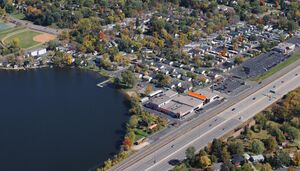
Difference between revisions of "Stormwater Program for Municipal Separate Storm Sewer Systems (MS4)"
| (5 intermediate revisions by 3 users not shown) | |||
| Line 1: | Line 1: | ||
| − | + | <!-- if you want code on table creation, look on this web page source code in the manual "Assessing total suspended sediment and total phosphorus removal efficiency of permittee owned/operated constructed stormwater ponds" | |
<!-- alerts are created using this command --> | <!-- alerts are created using this command --> | ||
| Line 7: | Line 7: | ||
<!-- | <!-- | ||
| + | additionally, call outs can be created using the "pre" command to open a block of text you want highlighted and then closed using /pre | ||
| + | --> | ||
| + | <!-- | ||
| + | |||
--> | --> | ||
| − | <!-- this file creates the picture on the screen. The file needs to be uploaded to the website in order to use this command as "Aerial city.jpg" is the file name stored on the wiki --> | + | <!-- this file creates the picture on the screen. The file needs to be uploaded to the website in order to use this command as "Aerial city.jpg" is the file name stored on the wiki. For example, the true image is stored on this web page https://stormwater.pca.state.mn.us/index.php?title=File:Aerial_city.jpg --> |
[[file:Aerial city.jpg|300px|left|alt=icon for MS4 stormwater]] | [[file:Aerial city.jpg|300px|left|alt=icon for MS4 stormwater]] | ||
<!-- | <!-- | ||
| Line 38: | Line 42: | ||
--> | --> | ||
<!-- to create links within the wiki the * makes a bullet point, the [ opens the link command, the url is where you want it to point and the words after the URL is the text you want displayed and then it must be closed by a bracket ] --> | <!-- to create links within the wiki the * makes a bullet point, the [ opens the link command, the url is where you want it to point and the words after the URL is the text you want displayed and then it must be closed by a bracket ] --> | ||
| + | <!-- alternatively, a second method can be used to link straight to pages in the wiki and that is just using double brackets ([[]]) with the page name inserted. So [[Stormwater Program for Municipal Separate Storm Sewer Systems (MS4)]] would create a link within the wiki itself as the wiki reads double brackets as an internal link. It is important to note that links are case sensitive so any word capitalized needs to be capitalized in the links too --> | ||
| + | <!-- to point to a section, it is just the page url then adding #section_name. So background information is a section in this page and to target that specific section it is fullregularurl#background_information --> | ||
*[https://stormwater.pca.state.mn.us/index.php?title=Aaron_test_MS4_page#Background_Information Background Information] | *[https://stormwater.pca.state.mn.us/index.php?title=Aaron_test_MS4_page#Background_Information Background Information] | ||
*[https://stormwater.pca.state.mn.us/index.php?title=Aaron_test_MS4_page#2020_MS4_General_Permit 2020 MS4 General Permit] | *[https://stormwater.pca.state.mn.us/index.php?title=Aaron_test_MS4_page#2020_MS4_General_Permit 2020 MS4 General Permit] | ||
| Line 69: | Line 75: | ||
| − | + | ignore this, this was experimental | |
<div title="A municipal separate storm sewer system (MS4) is a means of transportation, individually or in a system, (e.g. roads with drainage systems, municipal streets, catch basins, curbs, gutters, ditches, man-made channels, storm drains, etc.) that are: | <div title="A municipal separate storm sewer system (MS4) is a means of transportation, individually or in a system, (e.g. roads with drainage systems, municipal streets, catch basins, curbs, gutters, ditches, man-made channels, storm drains, etc.) that are: | ||
| Line 107: | Line 113: | ||
--> | --> | ||
| + | <!-- the command br is used to "force" an enter if it isn't registering with the system when enter is used to create a new line --> | ||
| + | <!-- the = sign is to set the "section level" that an item is at. This is the "heading 1,2,3" equivalent in Microsoft word. So = is top level == is level 2, === is level 3, etc. --> | ||
<br> | <br> | ||
==Background Information== | ==Background Information== | ||
| Line 123: | Line 131: | ||
==MS4 Stormwater Permits (Individual)== | ==MS4 Stormwater Permits (Individual)== | ||
*[https://stormwater.pca.state.mn.us/index.php?title=File:Mpls_MS4Permit_Mod.pdf 2018 Minneapolis Phase I Permit] | *[https://stormwater.pca.state.mn.us/index.php?title=File:Mpls_MS4Permit_Mod.pdf 2018 Minneapolis Phase I Permit] | ||
| − | *[https://stormwater.pca.state.mn.us/index.php?title=File:Final_Permit-StPaul_MS4Permit.pdf 2018 St. Paul Phase | + | *[https://stormwater.pca.state.mn.us/index.php?title=File:Final_Permit-StPaul_MS4Permit.pdf 2018 St. Paul Phase I permit] |
<br> | <br> | ||
| Line 154: | Line 162: | ||
*[https://mpca.maps.arcgis.com/apps/webappviewer/index.html?id=8d310e604baa43699b25395834d0c69a MS4 Mapping Tool] - An interactive online map tool to view and explore Minnesota MS4 boundaries, defined urbanized areas, impaired waters, outstanding resource value waters, trout waters and approved TMDL study areas.<br> | *[https://mpca.maps.arcgis.com/apps/webappviewer/index.html?id=8d310e604baa43699b25395834d0c69a MS4 Mapping Tool] - An interactive online map tool to view and explore Minnesota MS4 boundaries, defined urbanized areas, impaired waters, outstanding resource value waters, trout waters and approved TMDL study areas.<br> | ||
*[https://stormwater.pca.state.mn.us/index.php?title=MS4_fact_sheets Pollution Prevention Guidance Fact Sheets] - A Collection of Minnesota Stormwater Manual Fact Sheets on MS4 Stormwater Pollution Prevention Methods. | *[https://stormwater.pca.state.mn.us/index.php?title=MS4_fact_sheets Pollution Prevention Guidance Fact Sheets] - A Collection of Minnesota Stormwater Manual Fact Sheets on MS4 Stormwater Pollution Prevention Methods. | ||
| − | |||
<br> | <br> | ||
Latest revision as of 19:18, 14 August 2024
The municipal separate storm sewer system (MS4) stormwater program is designed to reduce the amount of sediment and pollution that enters surface and ground water from storm sewer systems. Public entities that own or operate an MS4 play a key role in preventing or reducing the negative impacts stormwater runoff has on our valuable water resources.
Proper stormwater runoff management in urbanized areas is especially important for restoring and protecting surface waters. Urbanized areas are more likely to have activities that contribute pollutants to stormwater runoff, like applying anti/deicing mixtures to roads; fueling vehicles; grease, oil, and other spills; landscaping; and using pesticides and fertilizers. Urbanized areas have a large amount of impervious surfaces, or surfaces that rain and snowmelt cannot pass through, such as streets, driveways, rooftops, parking lots and sidewalks. Stormwater runoff from these surfaces travels faster and in higher amounts, damaging rivers, streams, and wetlands; destroying aquatic habitats; increasing the amount of pollutants that enter surface waters; and limiting groundwater recharge and the MS4 program is to help mitigate the impact.
Contents
Background Information
Regulated MS4 permittees are required to develop a stormwater pollution prevention program (SWPPP) to reduce the pollutants entering the municipality's storm sewer system. When applying for the MS4 permit, permittees identified measurable goals they intended their SWPPP to reach. Based on these goals, permittees should evaluate the effectiveness of their program and make any necessary changes.
- What is a municipal separate storm sewer system (MS4)?
- Why is a municipality regulated under the MS4 permit?
2020 MS4 General Permit
- 2020 MS4 General Permit PDF Version
- 2020 MS4 General Permit Reissuance Page
- 2020 MS4 General Permit Wiki Version
- MS4 Annual Report
MS4 Stormwater Permits (Individual)
Previous Permits
Minimum Control Measures
When seeking to manage a Municipal Storm Sewer System (MS4), an effective Stormwater Pollution Prevention Program (SWPPP) has six different components known as Minimum Control Measures (MCMs).
- MS4 documentation required - What should I document under the MS4 Permit?
- Minimum Control Measures 1 - Public Education and Outreach
- Minimum Control Measures 2 - Public Participation/Involvement
- Minimum Control Measures 3 - Illicit Discharge Detection and Elimination
- Minimum Control Measures 4 - Construction Site Stormwater Control
- Minimum Control Measures 5 - Post-Construction Stormwater Management
- Minimum Control Measures 6 - Pollution Prevention/Good Housekeeping
Total Maximum Daily Loads (TMDLs)
Total Maximum Daily Loads (TMDLs) are EPA approved amounts of pollutant loading that can occur and have a water body meet water quality standards. Follow this link to learn more about them along with guidance and resources.
Tools and Resources
- Assessing Total Suspended Sediment and Total Phosphorus Removal Efficiency of Permittee Owned/Operated Constructed Stormwater Ponds - guidance related to assessing the total suspended sediment (TSS) and total phosphorus (TP) removal efficiency of MS4 (Municipal Separate Storm Sewer System) permittee owned/operated ponds constructed and used for the collection and treatment of stormwater.
- Checklist and Maintenance Documents and Examples of Procedures for MS4 BMP Methods
- MS4 Mapping Tool - An interactive online map tool to view and explore Minnesota MS4 boundaries, defined urbanized areas, impaired waters, outstanding resource value waters, trout waters and approved TMDL study areas.
- Pollution Prevention Guidance Fact Sheets - A Collection of Minnesota Stormwater Manual Fact Sheets on MS4 Stormwater Pollution Prevention Methods.
MS4 Audit Guidance
The U.S. Environmental Protection Agency (EPA) mandates the Minnesota Pollution Control Agency (MPCA) to evaluate MS4 permittees for compliance with the MS4 General Permit. The MPCA does this through compliance audits. To find out more information about the audit process see the pages below:
- EPA's measureable goal guidance for developing and evaluating a stormwater progarm's goal
- Phase II MS4 Audit Process
- Self-Audit Guidance for Phase II MS4s
MPCA MS4 Technical Assistance
- 2017 MS4 Technical Assistance and Outreach Needs Survey Results
- Green Communities A guidebook for developing clean water projects with Homeowners’ Associations - Washington Conservation District
- MS4 Case Studies
- MS4 Webinars and Videos
- MPCA MS4 Staff Contact Information
- MS4 Staff Site Plan Review Guidance
- MPCA MS4 Website
Other Resources and Documents
This page was last edited on 14 August 2024, at 19:18.

